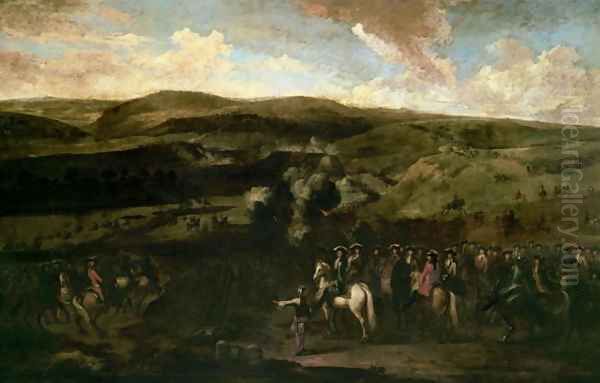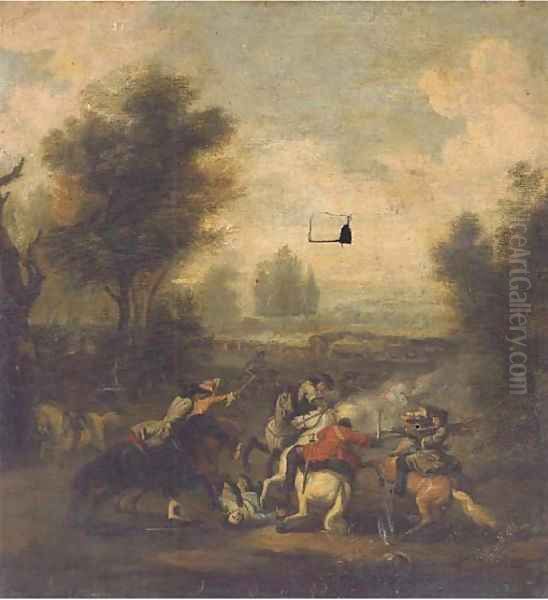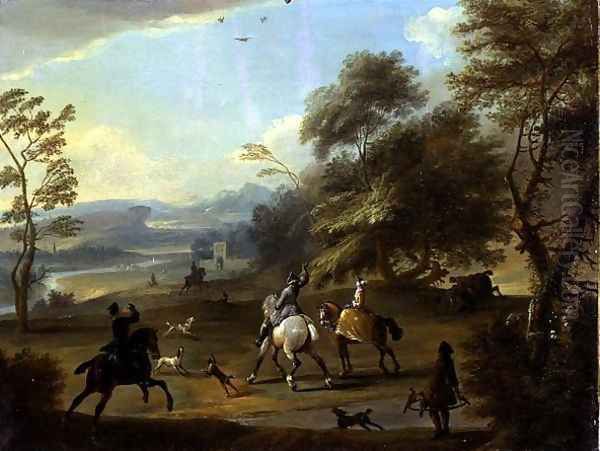Introduction
Jan Wyck stands as a significant figure in the transition of artistic styles between the Netherlands and England during the latter half of the seventeenth century. A Dutch painter by birth and training, he spent the most productive and influential part of his career in England. He became renowned for his dynamic depictions of battles, elegant equestrian portraits, lively hunting scenes, and evocative landscapes. While rooted in the traditions of the Dutch Golden Age, Wyck adapted his skills to the tastes and demands of his adopted homeland, leaving a distinct mark on the development of British art, particularly in the genres of military and sporting painting. His life and work offer a fascinating glimpse into the cross-cultural artistic exchanges of the Baroque era.
Early Life and Artistic Formation
The precise details of Jan Wyck's birth remain somewhat ambiguous, a point noted even in scholarly sources. Some records suggest he was born in Haarlem, a prominent artistic center in the Netherlands, around 1644. Other evidence points towards a birth year of 1652, possibly in The Hague. Regardless of the exact year, it is firmly established that he was the son of Thomas Wyck (c. 1616–1677), himself a respected painter known for his Italianate landscapes and genre scenes.
Jan received his primary artistic training from his father. This apprenticeship would have immersed him in the techniques and stylistic conventions prevalent during the Dutch Golden Age. This period was characterized by a high degree of realism, meticulous attention to detail, and a focus on subjects drawn from everyday life, landscape, and portraiture. Thomas Wyck's own experience, including time spent in Italy, likely broadened the scope of Jan's early artistic education, potentially exposing him to Mediterranean light and Baroque compositional ideas alongside Dutch naturalism.
Relocation and Career in England

Jan Wyck likely accompanied his father, Thomas Wyck, to England sometime after the Restoration of the monarchy in 1660, possibly around the mid-1660s or early 1670s. England, during this period, presented opportunities for skilled foreign artists. While native artistic traditions were developing, patronage from the monarchy and aristocracy often favoured painters from the continent, particularly the Netherlands and Flanders.
Settling in England, Jan Wyck established himself as an independent artist. He quickly gained recognition for his specialized skills. His ability to render horses with anatomical accuracy and dynamic energy was particularly valued. This proficiency made him a sought-after painter for equestrian portraits, a genre highly favoured by the English aristocracy. Furthermore, his talent for depicting complex, multi-figure compositions suited him well for battle scenes and hunting parties, subjects that resonated with a clientele interested in status, military prowess, and country pursuits. He became a prominent figure within the London art scene.
Artistic Style and Techniques
Jan Wyck's style represents a compelling fusion of his Dutch heritage and the influences encountered in England. His grounding in the Dutch tradition is evident in the careful observation, detailed rendering of textures (like armour, fabrics, and foliage), and often atmospheric treatment of landscapes. He employed oil paints with considerable skill, building up compositions with rich colours and distinct layers, characteristic of Northern European painting practices.
However, Wyck's work, especially his battle scenes, also incorporates elements of Baroque dynamism. His compositions are often filled with movement, dramatic action, and strong diagonal lines that guide the viewer's eye through the mêlée. While perhaps not as overtly dramatic as some Italian or Flemish Baroque masters, there is an energy and vigour in his depictions of cavalry charges and skirmishes that goes beyond staid representation. This blend allowed him to satisfy the English taste for both detailed realism and spirited action. His landscapes often served as more than mere backdrops, contributing significantly to the mood and narrative of the scene, echoing the Dutch landscape tradition of painters like Jacob van Ruisdael or Meindert Hobbema.
Master of Military Scenes

Jan Wyck excelled in the depiction of military subjects, becoming one of the foremost battle painters active in England during his time. His works in this genre ranged from generalized cavalry skirmishes to specific historical events. He possessed a keen eye for the details of military life – the uniforms, the weaponry, the formations, and the sheer chaos of combat. He often depicted cavalry engagements, showcasing his mastery in rendering horses in various states of action and repose.
One of his most celebrated works is William III and his Army at the Siege of Namur, 1695. This painting, considered a masterpiece by some sources, demonstrates his ability to handle large-scale compositions involving numerous figures and complex topographical details. It captures a significant moment in the campaigns of King William III, a major patron of the arts and a figure Wyck depicted on other occasions, such as in paintings related to the Battle of the Boyne. Works like Cavalry Battle with a Distant View of a Town (held at the Yale Center for British Art) further exemplify his skill in combining action with atmospheric landscape settings. The demand for such paintings was high, reflecting England's increasing involvement in European conflicts. His approach can be seen in relation to Dutch specialists in battle painting like Philips Wouwerman, though Wyck developed his own distinct manner.
Equestrian Art and the Hunt
Beyond the battlefield, Wyck applied his skill in portraying horses to equestrian portraits and hunting scenes. The horse was a symbol of status and power, and accurate, lively depictions were highly prized by the English gentry and aristocracy. Wyck provided portraits of nobles on horseback, often set against landscape backgrounds that further emphasized their landowning status and connection to country life.
His hunting scenes captured the energy and social aspects of the chase, another popular pastime among his patrons. These works often featured numerous figures, dogs, and horses interacting within a detailed natural setting. Wyck's ability to combine portraiture, animal painting, and landscape made him particularly well-suited for these commissions. This focus on equestrian and sporting subjects helped lay the groundwork for the great tradition of British sporting art that would flourish in the following century.
Landscapes and Topographical Views

While often integrated into his military or sporting scenes, Wyck also produced pure landscapes. These works continued the Dutch tradition of landscape painting but often depicted specific English locations or generalized British scenery. His landscapes are characterized by careful attention to natural detail, atmospheric perspective, and often a sense of calm that contrasts with the dynamism of his battle pieces. He sometimes included topographical elements, depicting castles or country estates within his landscape compositions, catering to patrons interested in representations of their properties or notable landmarks. His landscape work further demonstrates the successful transplantation of Dutch artistic conventions onto English soil.
Significant Works Re-examined
Several key works define Jan Wyck's contribution. The Siege of Namur painting stands out for its historical significance and compositional complexity, showcasing William III's military leadership. Variations of Cavalry Battle scenes, such as the one at Yale (Cavalry Battle with a Distant View of a Town) and another known as Cavalry Battle below a Fortress (recorded in a Dutch private collection), highlight his recurring interest and skill in this dynamic genre. These paintings typically feature swirling masses of horsemen engaged in close combat, often under dramatic skies and set within expansive landscapes that add depth and context.
Another notable theme is seen in works like Battle between Christian Cavalry and Turks, which reflects a broader European interest in conflicts with the Ottoman Empire, treated with Wyck's characteristic attention to equine and military detail. While perhaps less famous than the grand portraits by contemporaries like Sir Peter Lely or Sir Godfrey Kneller, Wyck's specialized works filled an important niche and demonstrated considerable artistic merit in their own right. Some sources suggest that certain works may have remained unfinished at the time of his death, offering potential insights into his working methods.
Influence and Legacy in British Art
Jan Wyck played a crucial role in the development of specific genres within British art. His arrival, along with other Netherlandish artists like the marine painters Willem van de Velde the Elder and Younger, significantly enriched the English artistic landscape, which had previously been dominated in portraiture by figures like Anthony van Dyck and later Lely and Kneller. Wyck specifically brought a sophisticated Dutch approach to battle painting, equestrian portraiture, and sporting scenes.
His influence is particularly noted on the next generation of British artists. John Wootton (c. 1682–1764), a leading figure in British sporting and landscape art, is considered to have been significantly inspired by Wyck, possibly even studying with him. Wootton adopted and adapted Wyck's manner of painting horses and integrating figures into landscapes, helping to establish a distinctly British school of sporting art. Wyck's success demonstrated the viability of these genres in the English market and helped pave the way for future specialists. He effectively acted as a bridge, transmitting Dutch expertise to English soil and stimulating native talent.
Wyck in the Context of European Art
While highly successful and influential in England, Jan Wyck's position within the broader European art historical narrative is more nuanced. He operated during the later stages of the Dutch Golden Age, a period that had produced towering figures like Rembrandt van Rijn and Johannes Vermeer. While Wyck was a highly competent and skilled painter, academic consensus generally places him as a significant but secondary master compared to these giants. His contribution is seen less in groundbreaking innovation and more in the skillful adaptation and transmission of established styles to a new cultural context.
His career also unfolded at a time when French art, under the influence of figures like Charles Le Brun and the academies established by Louis XIV, was increasingly setting the dominant trends across Europe. Wyck's success in England, rooted in Dutch traditions, represented a continuation of Northern European influence, particularly in genres less emphasized by the French academic system at that time. His father, Thomas Wyck, remains a notable figure in his own right, and some assessments view Jan as capably continuing the family workshop tradition rather than dramatically surpassing his father's achievements.
Personal Details
Information regarding Jan Wyck's personal life beyond his artistic career is relatively scarce. Sources indicate that he married three times during his life. His first wife's name is recorded as Anne Skinner, whom he married in 1676; she died around 1687. He subsequently married Elizabeth Holomberg in 1688, who died in 1693. His third wife was named Elizabeth, maiden name unknown. Despite these records of marriage, details about his family life, children, or personal character are not widely documented in accessible art historical accounts. He died in Mortlake, Surrey, on the outskirts of London, and was buried there on 26 October 1702.
Collections and Market Presence
Works by Jan Wyck are held in various public and private collections, primarily in the United Kingdom and the United States, reflecting his main sphere of activity. The Yale Center for British Art in New Haven, Connecticut, holds the aforementioned Cavalry Battle with a Distant View of a Town. Other institutions like the British Museum in London may hold drawings or prints by him or related to his work. Many of his paintings likely remain in British private collections, particularly those associated with historic country houses.
His works occasionally appear on the art market. Auction records provide some indication of his market value. For instance, the painting Cavalry Battle below a Fortress, noted as being signed and held in a Dutch private collection, was recorded as having sold at auction in the Netherlands for €12,000 against an estimate of €6,000–€10,000. While not commanding the prices of the very top tier of Old Masters, his works are recognized and valued, particularly those well-preserved examples showcasing his skill in military or equestrian subjects.
Art Historical Assessment and Research
Academic study of Jan Wyck acknowledges his importance as a key figure in Anglo-Dutch artistic relations during the late Stuart period. He is recognized as a pioneer in establishing battle and sporting painting as significant genres in England. His technical skill, particularly in depicting horses and detailed action, is generally praised. Scholars appreciate his role as a conduit for Dutch artistic practices and his influence on subsequent British artists like John Wootton.
However, compared to the extensive scholarship dedicated to major Dutch masters like Rembrandt or Vermeer, or even prominent Anglo-Netherlandish portraitists like Lely or Kneller, dedicated research on Jan Wyck remains relatively limited. He is often discussed within broader surveys of British art, Dutch art, or specific genres like military or sporting painting, rather than being the subject of extensive monographs. Some evaluations position him as a talented follower and transmitter of traditions, perhaps lacking the profound originality of the greatest masters, but nonetheless a crucial and successful artist within his chosen specializations and context. Further research could potentially illuminate more about his specific patrons, workshop practices, and the full extent of his oeuvre.
Conclusion
Jan Wyck carved out a successful and influential career as a Dutch painter working primarily in England. Arriving with a strong foundation in the Dutch Golden Age tradition learned from his father, Thomas Wyck, he adapted his skills to meet the demands of English patrons. He became a leading specialist in depicting the dynamic energy of battlefields, the elegance of equestrian life, and the pleasures of the hunt, often setting these scenes within meticulously rendered landscapes. While perhaps overshadowed in broader art history by the giants of the Dutch Golden Age, Wyck's contribution was vital for the development of British art, particularly in establishing military and sporting painting as respected genres. He remains a significant example of the fruitful artistic exchange between the Netherlands and England in the Baroque era, leaving behind a body of work appreciated for its skill, detail, and spirited depiction of action.